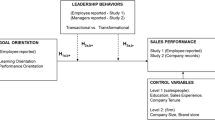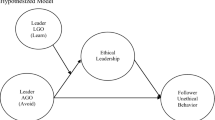Abstract
The value and importance of leadership is evident by its prevalence throughout human societies and organizations. In this work, mathematical models are developed to study two key attributes of leadership: setting goals and getting others in the organization to achieve those goals. The models contain controllable parameters whose values reflect the size of the organization, the actions taken by the individuals in the absence of a leader, the goal-setting skill of the leader (that is, the ability of the leader to identify goals that will result in good performance), and the buy-in skill of the leader (that is, the ability of the leader to get others to achieve those goals). The models provide insights as to when goal-setting skill is more important than buy-in skill and when buy-in skill is more important than goal-setting skill. Mathematical analysis is used to derive conditions under which buy-in skill both enhances and detracts from organizational performance.


Similar content being viewed by others
References
Bass B (1990) Bass and Stogdill’s handbook of leadership. Free Press, New York
Conger JHP, Kanungo B (1998) Buy-in leadership in organizations. Sage, London
Eisenhardt KM (1989) Agency theory: an assessment and review. Acad Manag Rev 14:57–74
Fiedler FF (1967) A theory of leadership effectiveness. McGraw-Hill, New York
French JHP, Raven B (1959) The bases of social power. In: Cartwright D (ed) Studies in social power. Institute for Social Research, University of Michigan, Ann Arbor, pp 150–167
Hazy JK (2007) Computer models of leadership: foundations for a new discipline or meaningless diversion? Leadersh Q 18:391–410
Hazy JK (2012) Leading large: emergent learning and adaptation in complex social networks. Int J Complex Leadersh Manag 2:52–73
Hazy JK, Ashley A (2011) Unfolding the future: bifurcation in organizing forms and emergence in social systems. Emergence, Complex Organ 13:57–79
Hersey P, Blanchard K (1996) Great ideas revisited: life-cycle theory of leadership. Train Dev 50:42–47
Humphreys JH, Pryor MG, Haden SP, Oyler JD (2009) The leadership of Joseph R. Walker: towards a model of socialized charisma through expert power. J Appl Manag Entrep 14:59–81
Kauffman SA, Levin S (1987) Towards a general theory of adaptive walks on rugged landscapes. J Theor Biol 128:11–45
Likert R (1961) New patterns of management. McGraw-Hill, New York
Pearce C, Conger J (2003) Shared leadership. Sage, Thousand Oaks
Phelps KC, Hubler A (2006) Toward an understanding on membership and leadership in youth organizations: sudden changes in average participation due to the behavior of one individual. Emergence, Complex Organ 8:28–35
Acknowledgements
This paper benefitted greatly from comments by three anonymous referees as well as the Area Editor, Brian Kulik. Specifically, while the models have changed only slightly from their original version, the terminology and references to the appropriate leadership literature have changed dramatically.
Author information
Authors and Affiliations
Corresponding author
Appendix
Appendix
Proof of (3)
It is shown by induction on n that \(A(\mathbf{z}, r)= 100 - \sum_{i=1}^{n}z_{i}^{2} - \frac{n}{3}r^{2}\). The statement is true for n=1 because:

Now assume that \(A(\mathbf{z}, r)= 100 - \sum_{i=1}^{n}z_{i}^{2} - \frac {nr^{2}}{3}\). Then for n+1 you have:

The proof is now complete. □
Proof of Theorem 1
The result is obtained by considering the effect of an additional amount δ of buy-in and goal-setting skill on the performance \(A(z, r) = 100 - n z^{2} - \frac{n}{3} r^{2}\) in (4):

It is now seen from (14) that if r<3z and 0<δ<3z−r, then A(z−δ,r)>A(z,r−δ), that is, this additional amount δ of goal-setting skill provides greater benefit than the same amount of buy-in skill. Similarly, if r>3z, then for any δ>0, A(z−δ,r)<A(z,r−δ), that is, any amount δ>0 of additional buy-in skill is better than the same amount of additional goal-setting skill. The proof is now complete. □
Proof that (7) satisfies the following KKT conditions

It is now shown that the following values satisfy the foregoing KKT conditions:
To see that conditions (a) and (b) are true, note that λ>0 and
Finally, to see that condition (c) is true, you have:
The proof is now complete. □
Proof of (2) for B r (z) in two dimensions:
It is now shown that, in two dimensions, \(A(\mathbf{z}, r)= 100 - (z_{1}^{2} + z_{2}^{2}) - \frac {1}{2} r^{2}\), when the region is B r (z). Specifically,
Shifting the origin to the point (z 1,z 2), the foregoing formula becomes
Now, letting x 1=Rcosθ and x 2=Rsinθ, it follows that

The proof is now complete. □
Proof of (12)
It is now shown that if the utility function f i (x) of individual i is distance decreasing (see Definition 1), then the solution to the optimization problem in (11) is:
Informally, the foregoing values are optimal for (11) because these values are the closest feasible values to x i (∞) and f i (x) is distance decreasing. More formally, if |x i (∞)−z i |≤r, then x i (∞) is feasible for (11) and, by definition of x i (∞), provides the maximum possible value of f i (x), thus solving (11). So assume now that |x i (∞)−z i |>r. Suppose first that z i <x i (∞). In this case, to see that z i +r is optimal for (11), let x be any action that is feasible for (11). It will be shown that f i (x)≤f i (z i +r). Now |x−z i | ≤ r and so it follows that x≤z i +r, or equivalently, x i (∞)−x≥x i (∞)−(z i +r)>0. Hence |x i (∞)−x|≥|x i (∞)−(z i +r)| and so, by the distance-decreasing property, f i (x)≤f i (z i +r), thus z i +r is optimal for (11). A similar argument shows that z i −r is optimal for (11) when z i >x i (∞). The proof is now complete. □
Proof of (13)
It is shown that if there is no individual i with x i (∞)=z i and r min=min{|x i (∞)−z i |:i=1,…,n}, and all utility functions are distance decreasing, then for any buy-in skill level r with 0≤r<r min, the optimal action of individual i is:
For any r with 0≤r<r min, by definition of r min, it must be that r<|x i (∞)−z i |. The result now follows from (12) and so the proof is complete. □
Proof of Theorem 4
To see how organizational performance p(x)=100−x T x behaves for buy-in skill level r∈[0,r min], observe from the foregoing proof of (13) that the optimal action take by individual i is given in (15). Accordingly, define the n-vector e by:
Noting that e T e=n and that the optimal vector of actions in (15) is x(z,r)=z+r e, the corresponding organizational performance is:
Now (16) is seen to be a concave quadratic equation in r whose maximum occurs at r max=−e T z/n. The desired conclusion of the theorem follows by considering where r max is in relation to [0,r min], which leads to the following three cases.
- Case 1 :
-
r max≤0. In this case, g(r) is decreasing on [0,r min]. This means that for any buy-in skill levels r 1 and r 2 with 0≤r 1≤r 2≤r min, g(r 1)≥g(r 2). In other words, organizational performance increases with increasing buy-in skill on [0,r min].
- Case 2 :
-
r max≥r min. In this case, g(r) is increasing on [0,r min]. This means that for any buy-in skill levels r 1 and r 2 with 0≤r 1≤r 2≤r min, g(r 1)≤g(r 2). In other words, organizational performance decreases with increasing buy-in skill on [0,r min].
- Case 3 :
-
0<r max<r min. In this case, g(r) is increasing on [0,r max] and decreasing on [r max,r min]. In other words, organizational performance increases with increasing buy-in skill from r min to r max and then decrease as buy-in skill increases beyond r max to 0. The proof is now complete. □
Rights and permissions
About this article
Cite this article
Solow, D., Szmerekovsky, J.G. Setting leadership goals and getting those goals accomplished: insights from a mathematical model. Comput Math Organ Theory 20, 36–51 (2014). https://doi.org/10.1007/s10588-013-9155-0
Published:
Issue Date:
DOI: https://doi.org/10.1007/s10588-013-9155-0




